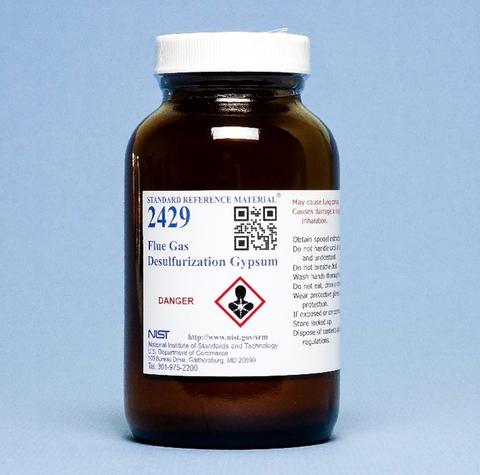Summary
New Standard Reference Materials (SRMs) consisting of activated carbon sorbent materials and flue gas desulfurization (FGD) gypsum are being developed to support specific mercury measurement needs associated with the operation and management of coal-fired electric utilities. Coal combustion represents the largest single anthropogenic source of mercury in the environment through stack emissions, but the implementation of mercury and sulfur emission reduction technologies is also resulting in elevated levels of mercury in the combustion by-products.
Description

Photograph of SRM 2429 Flue Gas Desulfurization Gypsum
The role of mercury in the environment is now receiving close scrutiny because ultimately it can bioaccumulate as alkyl mercury in seafood with subsequent risk to human health through trophic transfer. Many industrial sources of mercury have been effectively reduced in recent years, but atmospheric emissions of mercury from the operation of coal-fired power plants still remain the largest single anthropogenic source in the United States. In order to comply with new federal and state reduction regulations, there is a need to establish a valid measurement system. Most of the emissions monitoring will be made using continuous emission monitoring systems (CEMS) instrumentation, but sorbent systems, based on real-time batch capture of mercury from the stack using halogenated (iodine and bromine) activated carbon traps are becoming increasingly popular. The traps are subsequently returned to a laboratory for accurate analysis by cold vapor atomic absorption or fluorescence. These measurement methods are prone to interferences, especially in the presence of halogens. There is therefore a critical need for halogenated activated carbon sorbent reference materials to support quality assurance and analytical method development activities by the utility industry.
The combustion of pulverized coal in electric power plants produces sulfur dioxide gas emissions. In compliance with the 1990 U.S. EPA Clean Air Act and amendments, the emissions are reduced using wet scrubber flue gas desulfurization (FGD) systems. These systems are designed to introduce an alkaline sorbent consisting of lime or limestone into the exhaust gas system. The alkali reacts with the SO2 and is collected in a slurry form (approximately 24 million tons annually for U.S. FGD scrubber systems) as calcium sulfite or calcium sulfate. The calcium sulfate generated is stabilized with inert filler material such as fly ash and is re-utilized in industrial products such as wall board, fertilizers, and cement.
With the recent focus on the emission of mercury from coal-fired power plants, there is now concern about the release of sequestered mercury during the various processing stages of these materials and the content of mercury in the finished products. The recycling of combustion by-products is a big industry and the potential release of mercury to the environment from both processing and disposal of such materials could be significant, therefore extensive measurement testing is being conducted by the U.S. EPA, the industry sector, and industry consultants. To support these measurement efforts, there is a need for a stable SRM material certified not only for mercury but also for other hazardous elements.
Major Accomplishments
- Stability assessments have been completed and development of a new SRM for FGD Gypsum (SRM 2429) has been completed.
- Design of sampling equipment for exposing activated carbon to flue gas mercury emissions has been completed and two new activated carbon SRMs (SRM 2445 and SRM 2448) are now available .
- An analytical method based on isotope dilution inductively coupled plasma mass spectrometry (ID-ICP-MS) has been developed for the accurate measurement of mercury in complex matrices.
Additional Technical Details
The provision of halogenated activated carbon sorbent reference materials, certified for mercury, is a significant technical challenge. Halogenated materials obtained from commercial sources are being exposed to mercury emissions at a stack test facility located at the EPA-RTP using custom-designed sampling equipment. The advantage of this facility is that the mercury emission flux can be tailored to the desired material loading and generates a true matrix material compared with simple spiking using liquid mercury standards. The mercury content of the exposed material will be certified using a primary method based on isotope dilution ICP-MS, and additional data from other participating external collaborators.
The development and production of an FGD gypsum reference material is also in progress. Stability assessment is required to ensure that the mercury concentration in the material does not change over its target lifetime. Mercury is not the only element of interest to the environmental sector, and measurements are being conducted with specialist collaborating laboratories to provide leaching testing information on other toxic elements of interest such as selenium, chromium, lead, arsenic, and nickel.

